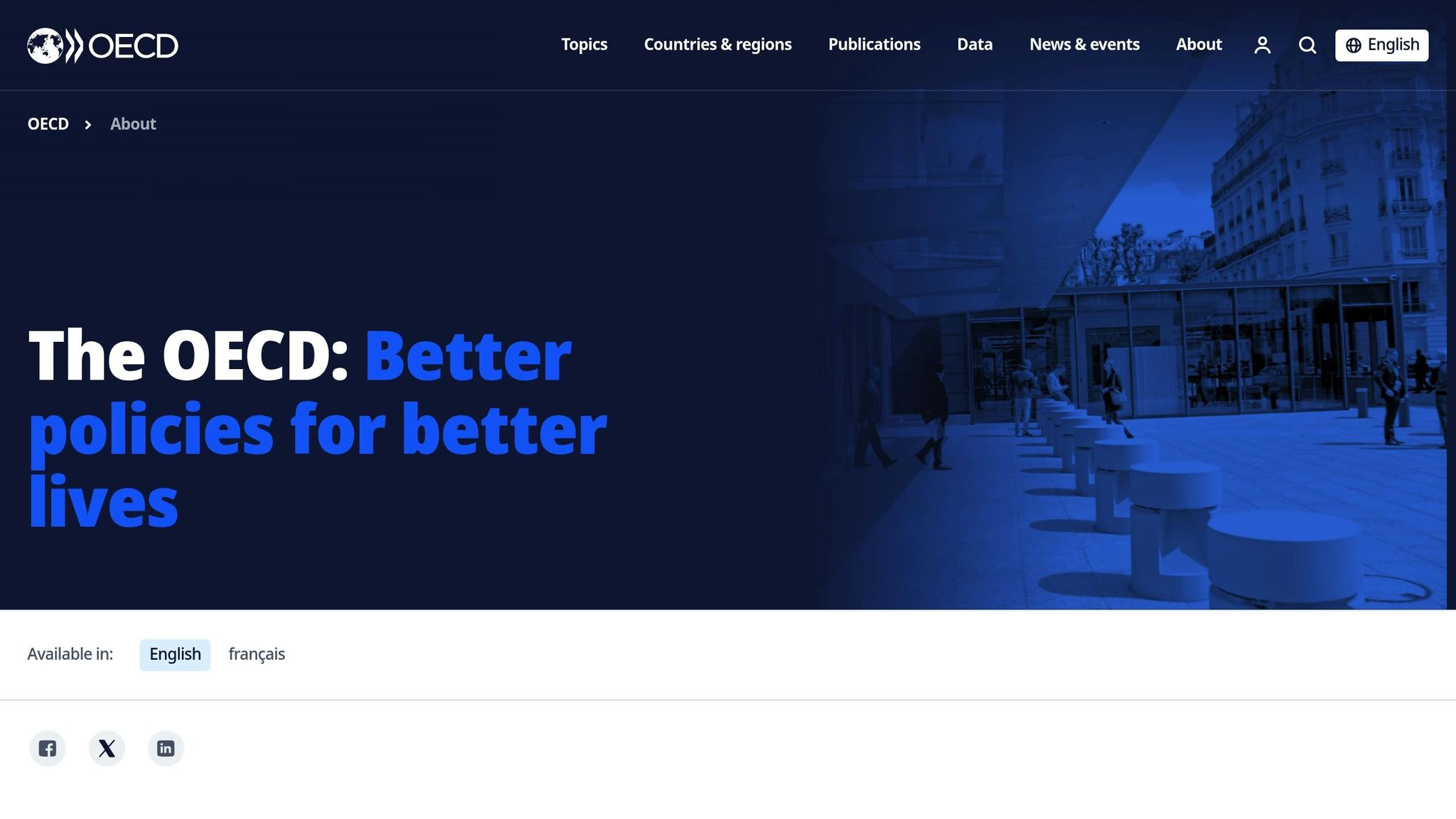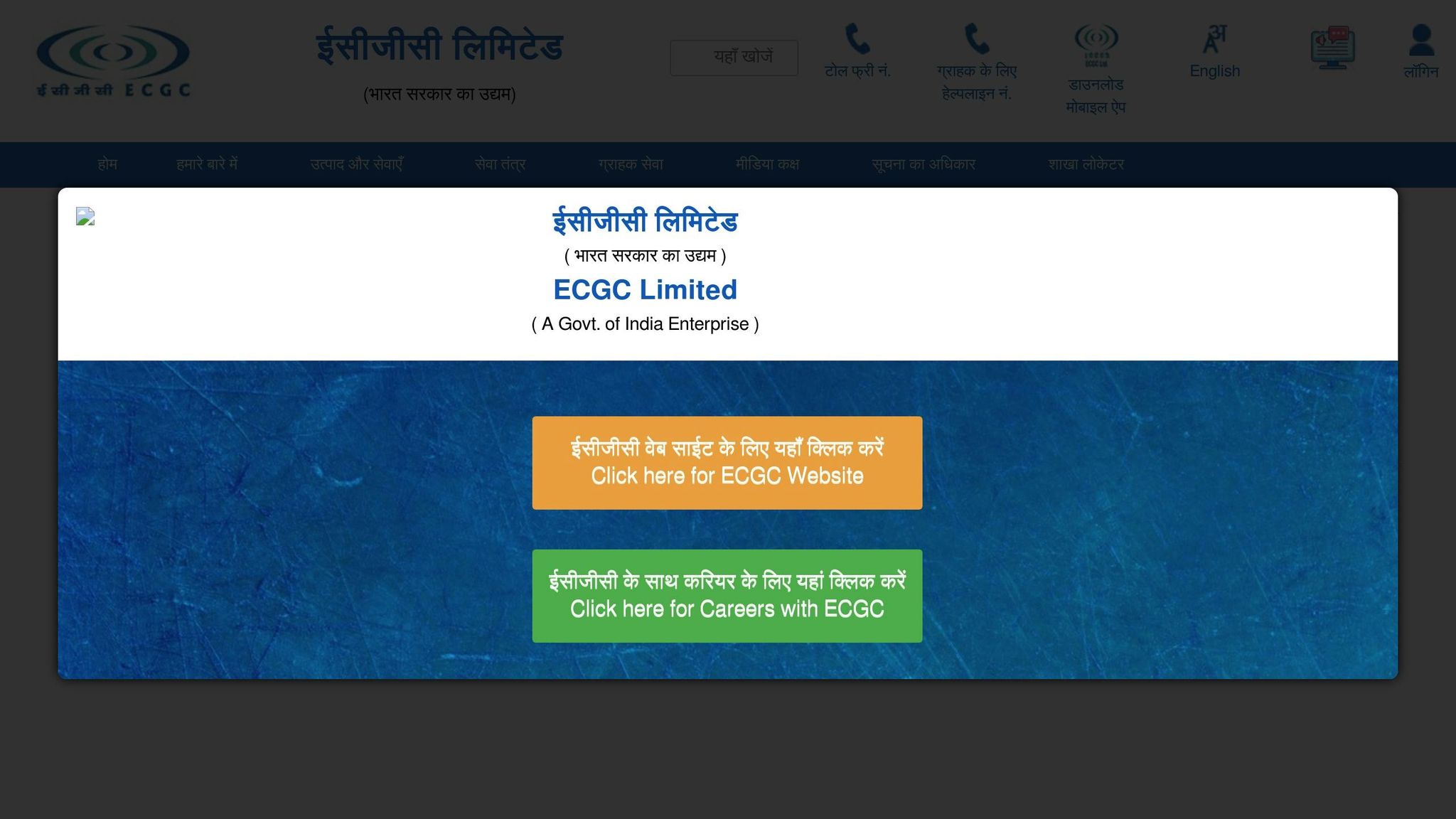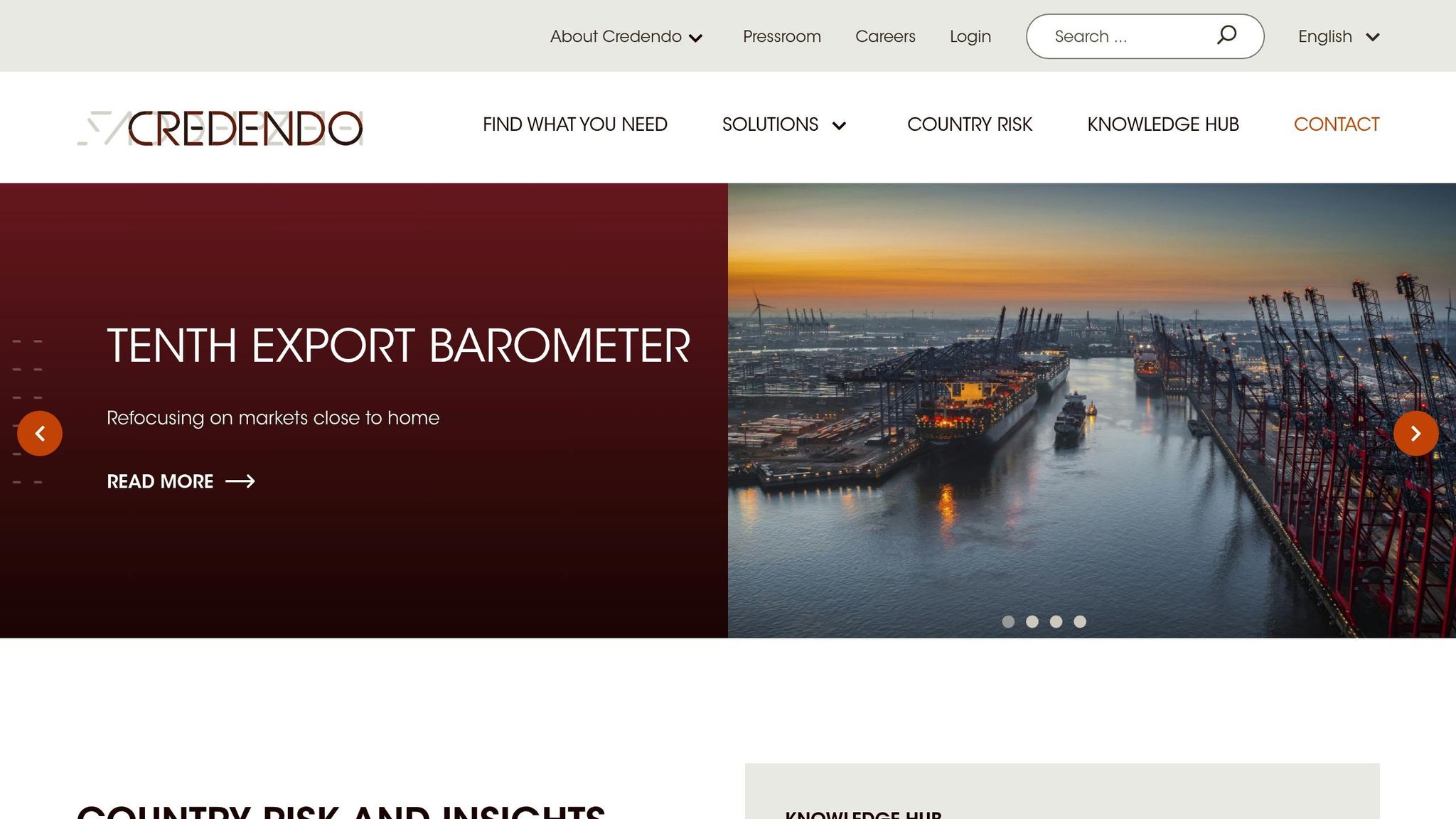When U.S. businesses trade internationally, they face risks like political instability, economic shifts, and buyer defaults. These risks directly influence insurance premiums for trade credit and accounts receivable coverage. Country risk classifications – like those from the OECD, ECGC, and Credendo – help insurers set premiums by evaluating a nation’s stability. For example, shipping to Germany (low risk) costs less than shipping to a high-risk country.
Here’s what you need to know:
- OECD: Rates countries from 0 (low risk) to 7 (high risk), impacting premiums for export credits.
- ECGC: Focuses on Indian exporters, adjusting premiums based on local risks.
- Credendo: Offers detailed risk ratings for short- and long-term transactions, with frequent updates.
Each system has strengths and weaknesses. Understanding these classifications helps businesses manage costs and protect against losses in global trade.
Country Risk: The 2024 Update
1. OECD Country Risk Classification
The Organization for Economic Co-operation and Development (OECD) oversees an important country risk classification system that plays a key role in global trade finance. This system sets Minimum Premium Rates (MPRs) for export credits, ensuring a standardized approach to assessing and pricing country risk.
The classification ranks countries on a scale from 0 (lowest risk) to 7 (highest risk). Each rating corresponds to a specific premium fee, designed to reflect the likelihood of non-repayment. This ensures that premiums are aligned with the assessed risk level.
Two-Step Assessment Methodology
The OECD uses a structured, two-step process to evaluate country risk:
- Step 1: Quantitative Analysis
The Country Risk Assessment Model (CRAM) examines several key factors:- Payment experience: A country’s history of servicing debts.
- Financial situation: Current fiscal health and debt levels.
- Economic situation: Stability and growth prospects.
- Institutional situation: Governance quality, measured through the World Bank Governance Indicators.
- Step 2: Qualitative Review
After the quantitative analysis, the Country Risk Experts’ Group (CRE Group) – a panel of experts from export credit agencies – conducts a qualitative review. This step accounts for additional factors like active conflicts, economic crises, or other extraordinary events that might not be fully captured by the quantitative model.
Risk Coverage Scope
The classifications address a range of risks, including transfer and convertibility risks caused by government-imposed controls. They also account for force majeure events such as wars, expropriation, or natural disasters that can disrupt payment obligations.
Geographic Coverage and Updates
The CRE Group convenes several times a year to update country classifications, ensuring timely adjustments based on significant changes. Each country is reviewed at least once annually. However, certain countries are excluded from this system:
- High-income OECD and Euro-Zone countries are assigned market ratings instead.
- Very small nations that rarely use official export credit support may also be excluded.
This regular review process ensures that premium adjustments remain relevant and reflective of current conditions.
Direct Premium Impact
For U.S. businesses involved in international trade, these classifications have a direct impact on costs. For instance, exporting machinery to a country rated 2 will result in lower premiums compared to exporting to a nation rated 6 or 7. This direct link between risk ratings and premium fees highlights the importance of the OECD system in managing trade credit risks.
For companies seeking to safeguard their international transactions, this system provides valuable insights. Businesses that utilize trade credit protection – such as Accounts Receivable Insurance (https://accountsreceivableinsurance.net) – can use these classifications to fine-tune their risk management strategies. By understanding the premium costs tied to specific country risks, companies can make informed decisions to protect their bottom line.
It’s worth noting that the OECD’s role in this process is administrative. The organization supports the classification framework but does not participate in the actual risk assessments. This ensures that the ratings remain technically independent and consistent.
2. ECGC (Export Credit Guarantee Corporation) Ratings
The Export Credit Guarantee Corporation (ECGC), India’s official export credit agency, plays a crucial role in assessing country risks, which directly influence premium costs for exporters and global businesses. These risk ratings provide insurers with the insights needed to adjust premiums in line with shifting market dynamics. Let’s break down ECGC’s assessment framework, its geographic influence, and how it calculates premiums.
Assessment Framework
ECGC evaluates several key factors to gauge national risk, including political stability, economic trends, financial health, and the overall commercial environment. This thorough analysis helps businesses and insurers make informed decisions about premium adjustments when engaging in international trade.
Geographic Coverage and Impact
ECGC’s ratings are continually updated to mirror real-world conditions, making them a valuable tool for businesses navigating global markets. For U.S. companies and other international traders, these ratings can significantly affect transaction costs and shape risk management strategies. For example, U.S. companies using Accounts Receivable Insurance (https://accountsreceivableinsurance.net) can use ECGC’s insights to better manage their cost exposure and make smarter trade decisions.
Premium Calculation Methodology
The ECGC employs a pricing model that starts with a base premium and adjusts it using multipliers linked to the assessed risk level. Lower-risk transactions benefit from reduced multipliers, while higher-risk scenarios lead to increased costs. This structured approach helps businesses anticipate expenses and plan their international trade activities with greater precision.
sbb-itb-2d170b0
3. Credendo Country Risk Assessment
Credendo, a Belgian export credit agency, has developed a country risk assessment system that directly impacts the premium costs for businesses involved in global trade. These classifications are essential for companies planning international transactions, serving as a guide for understanding potential risks. Let’s dive into how Credendo evaluates these risks and what their system entails.
Assessment Framework and Risk Categories
Credendo organizes its country risk assessment into two categories: Export Transactions and Direct Investments. Each focuses on different aspects of risk that influence premium rates. Countries are rated on two distinct scales: a political risk scale from 1 (lowest risk) to 7 (highest risk), and a business environment scale from A (most favorable) to G (most challenging). These ratings provide a comprehensive view of the risks tied to international operations.
Risk Assessment Components
For short-term risks (up to one year), Credendo relies on a quantitative model that evaluates liquidity metrics like external liabilities, currency reserves, current account balances, and refinancing options. When it comes to medium- and long-term risks (beyond one year), the agency assesses broader solvency indicators. These include economic and financial stability, political and institutional conditions, fiscal policies, external balances, and growth potential. Credendo also examines vulnerabilities such as export diversification and climate-related risks, ensuring a thorough analysis of each country’s situation.
OECD Alignment and Premium Impact
As a participant in the OECD Arrangement on Officially Supported Export Credits, Credendo aligns its medium- and long-term classifications with OECD standards. However, its Board of Directors may impose higher premium rates if a country’s risks exceed the standard evaluations. This flexibility allows Credendo to account for unique or emerging risks within its framework.
Market Coverage and Premium Calculation
Credendo’s regularly updated methodology ensures businesses, particularly U.S. companies using Accounts Receivable Insurance, can accurately estimate premium costs. These updates provide essential insights for navigating international markets, helping companies plan more effectively when engaging in cross-border trade.
Advantages and Disadvantages
Every country risk classification system has its strengths and weaknesses when it comes to determining premium costs for international trade insurance. Understanding these nuances can help businesses choose the system that aligns best with their specific needs. Let’s take a closer look at how these systems compare.
The OECD Country Risk Classification is widely recognized for its global consistency and transparency. Export credit agencies around the world rely on this system to set minimum premium rates, ensuring a uniform approach across international markets. Its straightforward 0–7 risk scale makes premium calculations easier to understand, while combining quantitative data with qualitative expert input ensures both economic and political risks are considered.
That said, this system has its limitations. Annual updates may not keep pace with rapidly changing events, and its broad categories can sometimes oversimplify complex, country-specific risks. Additionally, the use of qualitative assessments introduces an element of subjectivity.
India’s ECGC ratings, developed by the Export Credit Guarantee Corporation, take a more localized approach. These ratings are tailored to reflect risks specific to Indian exporters, factoring in local market conditions and priorities. This focus allows ECGC to capture details that global systems might overlook. However, the system’s localized nature makes it less useful for businesses operating across multiple international markets, as it lacks the global comparability offered by OECD standards.
The Credendo system stands out for its highly detailed risk assessments. It updates frequently and considers a broad range of factors, including sector-specific vulnerabilities, which allows for more precise premium pricing. This system excels at identifying emerging risks quickly, offering valuable real-time insights for businesses managing complex transactions. However, its complexity can make it challenging for non-specialists to interpret, and its proprietary methodology may complicate efforts to benchmark premiums across different systems.
The impact of these differences is evident when calculating premium costs. For instance, a power generation project in Ghana with an S&P rating of B– had its country risk premium set at 6.30% without political risk insurance. This dropped to 2.23% when conventional political risk coverage was applied. Depending on the classification system used, Ghana’s risk profile – and consequently the premium – could vary significantly for the same project.
| Classification System | Key Strengths | Primary Weaknesses | Best Use Case |
|---|---|---|---|
| OECD | Globally consistent, transparent, widely used for setting minimum premiums | Updates may lag; broad categories may oversimplify risks | Ideal for export credit agencies and global trade insurers |
| ECGC | Tailored to Indian exporters, reflects local market nuances | Limited global comparability; less transparent than OECD | Best for Indian exporters and localized trade finance |
| Credendo | Detailed assessments, frequent updates, real-time risk insights | Complex to interpret; proprietary methodology | Suited for specialized risk management and high-risk transactions |
Table summary: Key factors influencing premium pricing for each system.
For U.S. businesses using Accounts Receivable Insurance, these differences have a direct impact on premium costs and coverage terms. For example, a U.S. company trading with multiple international partners might benefit from the OECD system’s consistent baseline for premium calculations. On the other hand, Credendo’s detailed analysis could be more useful for high-risk, specialized transactions. Meanwhile, ECGC ratings are most relevant when trade is concentrated in specific regions where local expertise is critical.
Ultimately, the choice of system depends on the complexity of the transaction and the geographic focus. For straightforward international trade, the OECD’s standardized approach works well. For high-value or complex deals in volatile markets, Credendo’s granular insights can be invaluable. And for businesses with a strong regional focus, ECGC’s localized expertise offers a tailored solution. These distinctions guide how businesses approach premium pricing strategies in different regions.
Conclusion
Country risk classifications play a key role in determining premium costs for U.S. companies engaged in international trade. Whether it’s the OECD’s global standard, ECGC’s regional insights, or Credendo’s in-depth evaluations, each system has unique features that can lead to differing financial impacts for businesses. These distinctions, as outlined earlier, are crucial for shaping strategies and managing costs effectively.
Premium fluctuations based on these classifications can have a noticeable effect on a company’s bottom line. This means businesses need to choose the system that aligns best with their trade activities. For example, companies with diverse international operations might find the OECD’s consistent framework a better fit. On the other hand, businesses focusing on high-risk or niche markets may benefit from Credendo’s detailed analyses. Meanwhile, firms with a regional focus could leverage ECGC’s expertise for more specialized insights.
To navigate these complexities, working with seasoned providers is essential. Accounts Receivable Insurance offers tailored policy solutions and risk assessments that integrate multiple classification systems. Their global network of credit insurance carriers allows businesses to assess how these various systems influence their risk profiles and premium costs.
Staying ahead also requires regular reviews of classification updates. By combining this proactive approach with pre-claim support and expert broker guidance, companies can secure cost-effective coverage while minimizing non-payment risks.
Understanding and leveraging these systems equips U.S. businesses to manage costs more effectively and strengthen their position in the global market.
FAQs
How do country risk classifications affect premium costs for U.S. businesses trading internationally?
Country risk classifications are an important factor in shaping insurance premium costs for U.S. businesses involved in international trade. These classifications help insurers gauge the economic and political stability of a country, offering a clearer picture of the potential risks, like non-payment or political upheaval, that businesses might face.
For example, trading with countries that have higher risk ratings often leads to higher insurance premiums due to the increased financial uncertainty. On the flip side, countries with lower risk ratings generally result in lower premiums. This system allows insurers to provide the necessary protection for businesses while aligning costs with the specific risks tied to doing business in various regions.
How do the OECD, ECGC, and Credendo risk classification systems differ, and what impact do they have on premium costs?
The OECD, ECGC, and Credendo each have their own approach to evaluating country risks, and these variations can directly influence insurance premiums. The OECD emphasizes economic and political stability, offering a framework that shapes sovereign risk premiums. Meanwhile, ECGC employs a scale from A1 (lowest risk) to D (highest risk), focusing on creditworthiness and political stability. Credendo takes a different route, utilizing its proprietary methods to assess risks specific to individual countries.
These differences matter because higher risk classifications often translate into higher premiums. For instance, a country deemed high-risk by a more conservative system could result in elevated premium rates to offset the perceived financial exposure. By understanding these classification systems, businesses can better anticipate insurance costs and make well-informed decisions when addressing country-specific risks.
How do country risk classifications affect premium costs for U.S. businesses managing international trade risks?
Country risk classifications are an important factor in setting premium costs for U.S. businesses engaged in international trade. These classifications evaluate elements such as political stability, economic conditions, and the reliability of payments in various countries. Insurers use this information to gauge the risks tied to operating in specific regions.
For U.S. companies, selecting an appropriate classification system is key to getting a precise risk assessment. This not only affects the cost of insurance coverage but also empowers businesses to make smarter decisions to safeguard their finances. In markets that are unpredictable or unstable, understanding these risks becomes even more critical for securing better trade terms and protecting investments.






